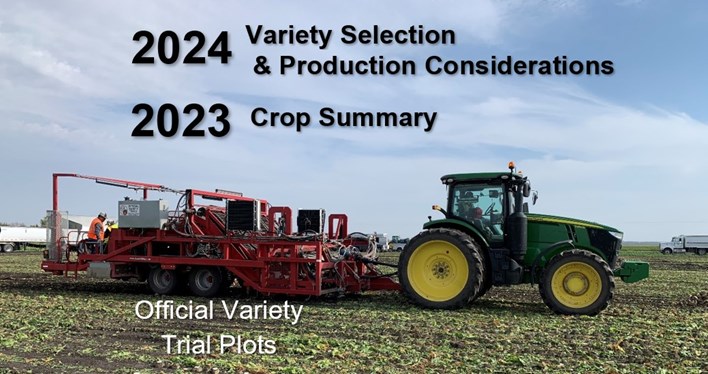634 - 2024 Variety Selection & Production Considerations & 2023 Crop Summary

2023 Official Coded Variety Performance Trial Data
Many growers have already purchased seed for the 2024 sugarbeet crop. Now is a good time to review the OVT data and be sure that the varieties you’ve selected offer the appropriate characteristics of disease tolerance, yield, and sugar quality for placement in each unique field on your farm.
OVT trial data can be downloaded in a PDF document or an Excel file. Both have the same data sorted in 8 different ways. Color coded disease tolerance ratings can help you distinguish between the different degrees of tolerance.
OVT variety data is pre-sorted in the 2023 Variety Selector in the following ways (each on a separate page):
- Seed Company
- Rev/Ton
- Rev/Acre
- Aphanomyces Tolerance Rating
- Rhizoctonia Tolerance Rating
- Fusarium Tolerance Rating
- Cercospora Tolerance Rating
- Emergence Percent
Downloading the Excel version will allow you to create your own sorts to examine the data as well.
Considerations on Variety Placement
- Past variety performance on your farm.
- Known disease presence in fields to be planted in 2024.
- Links to general township disease presence observations & management recs:
- Historical production characteristics by field.
- Below average sugar and/or above average tons:
- Consider a higher sugar variety to optimize recoverable sugar/acre.
- Above average sugar and/or below average tons:
- Consider a higher yielding variety to optimize recoverable sugar/acre.
- Below average sugar and/or above average tons:
- Pre-piling from designated fields, headlands, and splits:
- Use high sugar varieties to help maximize your Pre-pile Premium
- Field distance from piling site/factory:
- If long distance, consider higher sugar, moderate tonnage varieties to lower transportation costs.
CR+ Variety Placement Considerations
- Fields/areas not planned for Pre-pile deliveries:
- Take full advantage of higher Cercospora tolerance further into the growing season.
- Fields bordering previous year’s beet fields.
- Fields protected from wind (higher humidity), river fields, shelter belts.
- Fields farther away that may be difficult to reach for timely fungicide applications.
Production Considerations in 2024
We look forward with optimism to next year’s crop potential and general production challenges to prepare for. Each topic heading is a link to its subject material on the Crystal website.
- As always, check with your pesticide supplier to make sure you have access to pesticides needed for your 2024 sugarbeet crop production.
- Rainfall remained below average for the growing season, and we may be going into next spring very dry. Field preparations need to conserve as much moisture as possible by not working ground too far ahead of the planter.
- Cover crops should also be used to protect seedling sugarbeets and limit erosion from strong spring wind events.
- All areas of the Red River Valley need to have a plan to control glyphosate resistant weeds. Particularly waterhemp, kochia, and common ragweed.
- For waterhemp, this plan should incorporate a layered approach of soil applied herbicides, that includes a PPI/PRE herbicide application along with 2 POST Lay-by herbicide applications.
- Kochia requires the use of PPI/PRE applied ethofumesate. For Post applications, scout and time Spin Aid treatments on small “puff ball”, dime-sized kochia.
- Treat common ragweed when it’s small, <2”, with Stinger/Stinger HL.
Sugarbeet Root Maggot (SBRM) - Continued High Pressure
- 2023 saw high SBRM populations again. Accordingly, populations are forecast to be high in 2024.
- The best treatment for SBRM control is using:
- Counter insecticide At-Plant followed by POST insecticide applications.
- Multiple POST insecticide applications may be needed for optimal control to reduce egg-laying fly populations.
- Thimet granular POST offers great SBRM control.
- Prepare to use Mustang Maxx or Asana as POST liquid insecticides.
- At this moment Chlorpyrifos cannot be used. Even though the court case was successful for Chlorpyrifos, there are still numerous items that need to be addressed before Chlorpyrifos can be an allowable, labeled insecticide application.
- At this moment Chlorpyrifos cannot be used. Even though the court case was successful for Chlorpyrifos, there are still numerous items that need to be addressed before Chlorpyrifos can be an allowable, labeled insecticide application.
Cercospora Leafspot (CLS)
- The proper timing of initial & subsequent CLS fungicide applications helped to proactively keep Cercospora in-check, maintain healthy leaves, and optimize variety performance.
- Cercospora could be easily found in fields but was generally at low levels and did not reach the level of severity witnessed in 2020 & 2021.
- Within the same growing area, it was observed that a higher prevalence of Cercospora infection occurred in fields that had later initial fungicide applications compared to those fields with earlier applications.
- A timely initial fungicide application is needed to delay the on-set of Cercospora infections thereby reducing end-of-season severity levels.
- Target initial fungicide applications by July 7th.
- Tank-mix and rotate fungicide modes of action for resistance management and maintain proper fungicide application intervals.
- Planting varieties with good CLS ratings can make a big difference in infection levels. However, this may not equate to fewer fungicide applications.
Note: The Official Variety Trials use the ACSC recommended CLS fungicide program.
- In the OVT data, cross reference variety performance against their Cercospora tolerance ratings
CR+ varieties still require timely initial and subsequent fungicide applications to optimize varietal performance.
Do so to maintain the CR+ trait’s effectiveness against CLS into the future.
2024 Sugarbeet Winter Meeting Schedule
- Sugarbeet Research and Reporting Session
- January 9th @ Holiday Inn in Fargo, ND
- Sugarbeet Grower Seminars
- Fargo - February 6th @ Fargo Holiday Inn
- Grand Forks – February 13th @ Alerus Center in Grand Forks
- Grafton – TBD
- International Sugarbeet Institute – March 13th & 14th @ Alerus Center in Grand Forks, ND
